Featured Articles
Machete Knife | Things You Need To Know About A Machete

Throughout history, many great tools have been born out of mankind’s need to survive. Few have had the impact and the adaptability of the machete knife.
RELATED: Survival Machete | Top 10 Best Machetes for Survival 2022
Machete Knife: A Beginner’s Guide

History of a Machete Knife
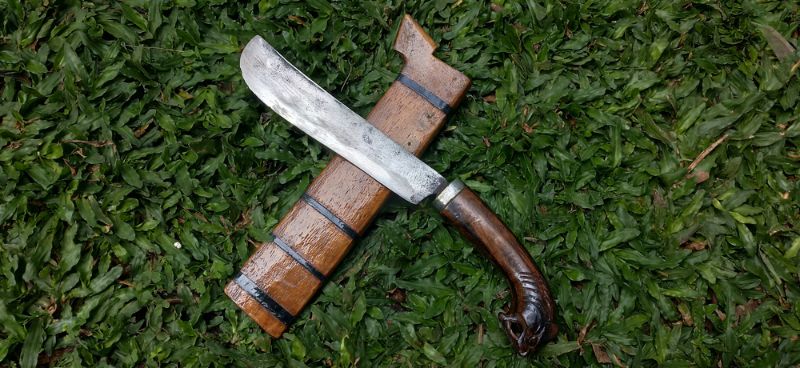
From the South American Amazon to the African Serengeti, the use of machetes is global. The long fixed blades make them ideal for cutting trails and clearing brush.
They are also a top choice of sugarcane farmers. The simplicity of the design and the effectiveness lead to the tool becoming an icon.
The billhook made cutting through vegetation and small trees easier. As time progressed, similar tools developed reached symbolic status, and became ritualized.
Stemming from need and ease of use, machete-like tools began popping up all over the world.
Machetes have also found their way onto the battlefield. Guerrilla forces and military soldiers have carried them as both tools and weapons.
In particular, the Macheteros, have centuries-old ties back to sugarcane farmers. Rebels in Cuba have also used machetes in many conflicts with opposing forces.
In some countries, machetes have even replaced handguns as the standard sidearm.
The African country of Angola even included the image of a Machete on its flag.
Inspired by the Soviet hammer and sickle, the red and black flag features a cog and machete. A cog to represent industrial workers and the machete for agriculture.
Machete Knife Types and Styles
1. Latin

Originating from Latin America, this is the most recognized version of the machete. Blade lengths range from 18 to 24 inches and are best used in light vegetation.
Used for cutting and chopping. Also known as a bush machete.
2. Bolo
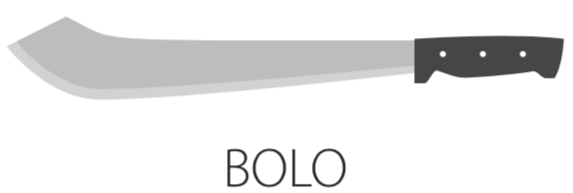
The Philippines-based Bolo has a blade length between 20 and 24 inches and is a multi-use tool. Like the heavy machete, it has a thicker weighted blade.
3. Panga

This African multi-use machete has a blade length of 20 inches. A distinct curved design makes it great for cutting wood.
This design is used in the Caribbean and has a relative named the Tapanga that also originated in Africa.
4. Bowie
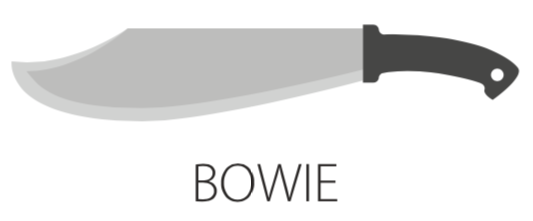
Knife-like in its appearance. Originating from America with a typical blade length of around 12 inches.
This machete is a mix between a bowie knife and a machete. Regarded as the best survival machete it gets its namesake from Jim Bowie.
5. Golok

Used for shaping wood, the golok has a curved blade and originated in South-East Asia. This machete is a symbol of masculinity to the people of Indonesia.
6. Barong

An Asian machete with a single edge design and a heavy leaf-shaped blade. The slicing ability and heaviness make them ideal for hunting and slaughtering livestock.
7. Cane
Born in South America and used to cut sugar cane. The forward weighted cane machete is also used to cut bamboo and heavy foliage.
Cane machetes feature a hook on the backside of the tip like most other designs.
8. Kukri

This curved blade chopper hails from Nepal. It has a curved blade ranging from 16 to 18 inches. Ideal for jobs suited for large fixed blade knives.
Militaries around the world issue the Kukris as a survival tool.
9. Parang

Used for chopping and batoning, this Asian machete has a curved blade. The parang has a longer and more curved blade than the golok.
Machete Knife Blade Construction
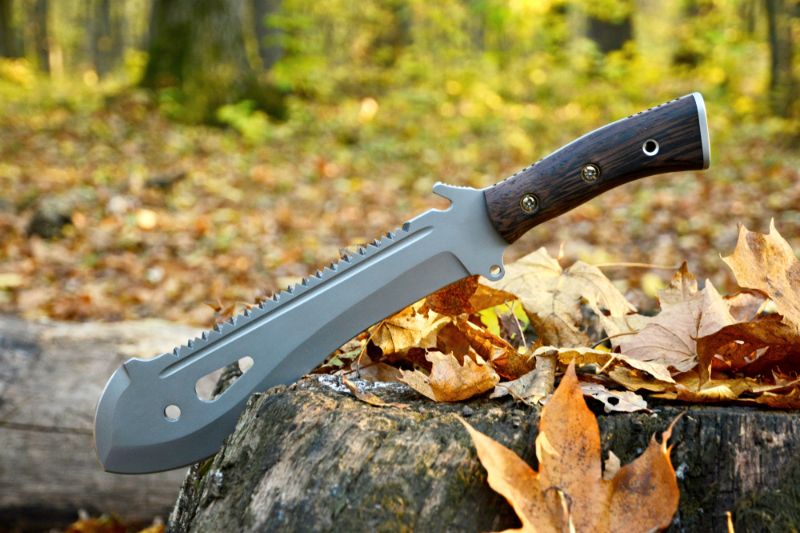
1. Stainless
An expensive option resistant to stains and requires less maintenance. Dulls are much faster than carbon but it’s easy to resharpen.
2. Carbon
Harder and less expensive than stainless. This type requires oil often to avoid rust. Carbon will keep a sharp edge longer than stainless.
3. High-Carbon Stainless
The newest material used. Combines the best of both worlds. The rust resistance of stainless and the strength of carbon.
Machete Knife Construction
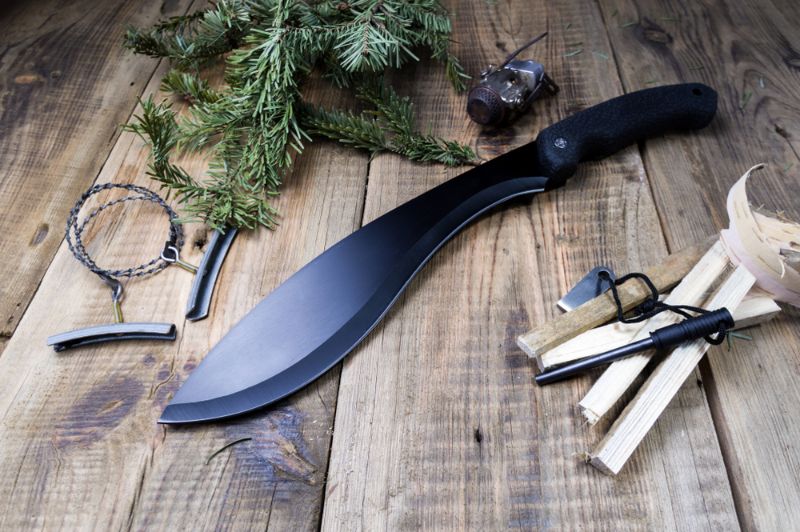
As the styles of the blade, there are different types of handles. Each handle design has a specific point and purpose.
1. Crossguard
Designed to keep your hand from slipping across the blade. It is a heavy design and may not fit all hands.
2. Knuckle Guard
Like the crossguard, the knuckle guard will not fit all hands and does tend to be heavier. The design protects the hand and knuckles and keeps your hand from sliding off the handle.
3. Quillon
The quillon design will keep your hand from sliding across the blade. It will not protect your hand and knuckles like the crossguard and knuckle guard.
Machete Knife Handle Construction
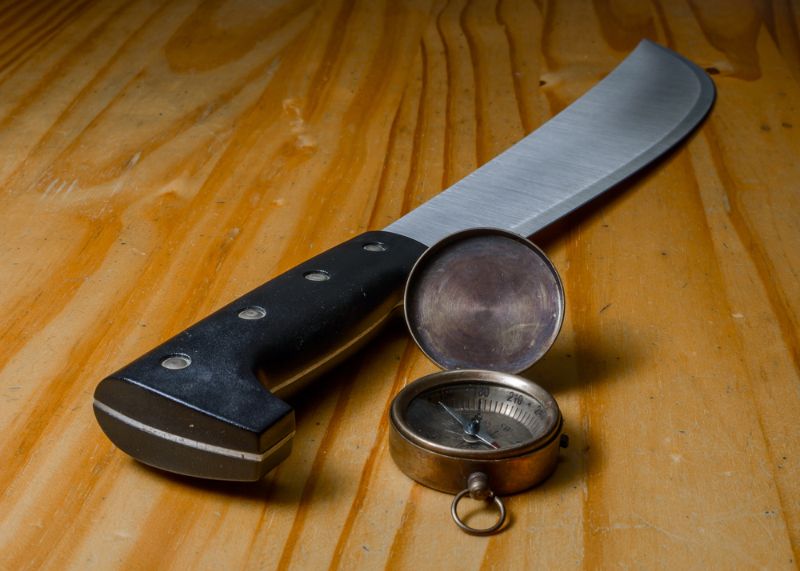
There are different materials used in handle construction as well. Handles are made for their longevity and are made for their resistance to bacteria.
The handle is made from expensive materials and ones made from cheaper materials.
1. Micarta Handles
By far the most expensive. Constructed from layers of plastic, linen, or fiberglass. These grips are the most comfortable and longest-lasting.
2. Textured Handles
Inexpensive handles provide a good grip. Because of their rubber construction, they can become worn and torn.
3. Stainless Handles
Another expensive option. Resistant to bacteria but can become slippery during use.
4. Wooden Handles
Not as expensive as stainless or micarta, but more than plastic. Known for harboring bacteria. It requires the most maintenance.
5. Plastic Handles
By far the cheapest option. They are easy to maintain but will crack easier than others. It can become slippery during extended use.
Machete Knife or Axe?
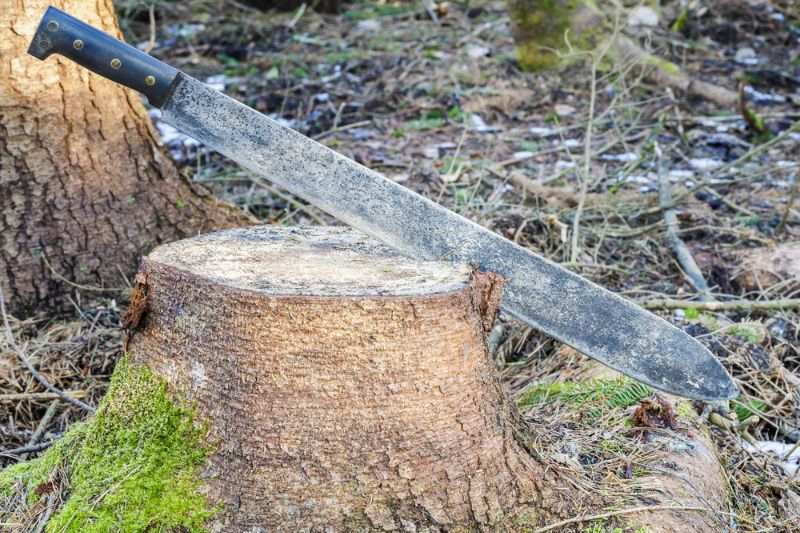
Two tools with similar uses but different applications. One design is best suited for chopping whereas the other is best for hacking.
Machetes are longer and thinner and axes are short with thicker blades. Machetes are lighter and users will tire slower than those using heavier axes.
The weight of each can be a pro or a con depending on the application.
If you are chopping firewood a machete is useless in the same way a hatchet is when clearing light foliage. If you can’t decide which one is best for you, you may not have to.
Recently, a few companies have developed a Machete-Axe. These unique hybrids combine the blade length of a machete with the heavy head of an axe.
This strange but effective combo allows you to chop, split and clear brush with one tool. Innovation has been a driving factor in the history of machetes.
This latest incarnation is no different.
Storing And Caring For Your Machete Knife
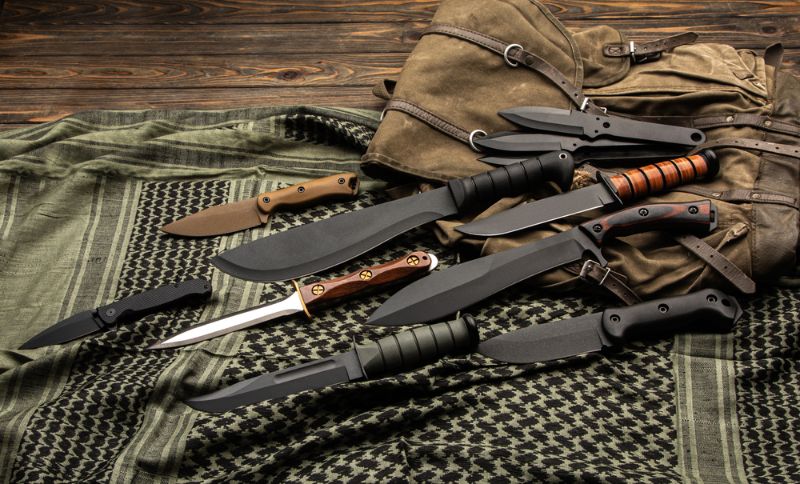
Machetes are versatile tools, but they have one enemy and vulnerability, rust. Because of this, it is crucial that you store your machete in a dry location and when in storage keep it out of the sheath.
Whichever style machete fits your purpose best, it is imperative you maintain it and care for it. Since carbon steel blades are prone to rust apply a light coat of oil after use.
Stainless steel will hold up better against the elements but you should oil them from time to time. Handle maintenance is simple, especially if you have a plastic handle.
Wooden handles need periodic oiling and are achieved by using a light rub down of furnish polish.
Sharpening Your Machete Knife
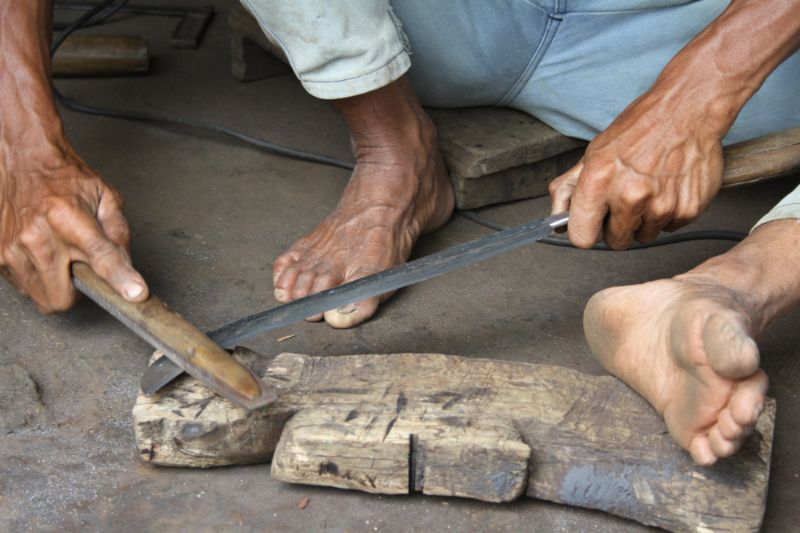
In most cases, using a field sharpener is enough to keep a sharp edge on a machete while you are working. After an extended period of use, or if your machete comes without an edge, you will need a heavier sharpener.
Like every other aspect of machetes, the angle of edge you choose will be completely based on your needs. A 20 to 25 degree works best for non-woody applications.
For branches and mixed woody vegetation, 25 to 35 degrees is ideal. Mill files, grinding wheels, and belt sanders are great sharpening tools for machetes.
Each has pros and cons and specific methods of use. When using all three it is imperative you keep an eye on the blade temperature so it does not lose its temper.
I recommend that you research the three tools and find the one you are most comfortable with.
Watch this satisfying video from Masters of Craft of restoring a machete:
That has made machete knife a staple of outdoor adventures and projects for centuries. Regardless of where you are, what you need, or what you are doing, chances are there is a machete perfect for you.
Latin or Bolo? Panga or Bowie? Wooden Handle or Plastic? Carbon blade or Stainless blade? It’s up to you and there is no wrong answer. Tell us in the comments section below.
Up Next:
- Can Your Machete Hack it?
- The Best Survival Weapon
- 14 DIY Badass Weapons That Can Save Your Life When SHTF [2nd Edition]
Don’t forget to stay connected with us on Facebook, Twitter, Pinterest, and Instagram!
-

 Do It Yourself7 months ago
Do It Yourself7 months agoParacord Projects | 36 Cool Paracord Ideas For Your Paracord Survival Projects
-

 Do It Yourself9 months ago
Do It Yourself9 months agoHow To Make Paracord Survival Bracelets | DIY Survival Prepping
-

 Do It Yourself9 months ago
Do It Yourself9 months ago21 Home Remedies For Toothache Pain Relief
-

 Do It Yourself10 months ago
Do It Yourself10 months agoSurvival DIY: How To Melt Aluminum Cans For Casting
-

 Exports8 months ago
Exports8 months agoAre Switchblades Legal? Knife Laws By State

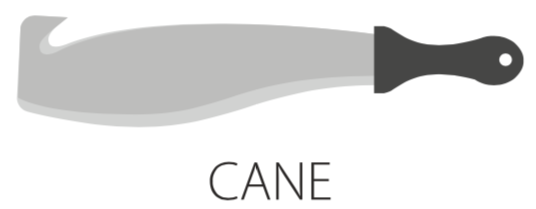

Pingback: Machete: A Beginner’s Guide
Pingback: Machete: A Beginner’s Guide | Life Off The Grid
Pingback: Machete: A Beginner’s Guide – Ultimate Survival Alerts
Pingback: Machete: A Beginner’s Guide - Survival Patch
Pingback: How to Use an Axe | Bushcraft Axe Skills - Primal Survival
Pingback: How to Use an Axe | Bushcraft Axe Skills – Sprent Brass
Pingback: Survival Machete | Top 10 Best Machetes for Survival 2022 – The Self-Sufficient Life
Pingback: Survival Machete | Top 10 Best Machetes for Survival 2022 - Cooking in Quarantine
Pingback: Survival Machete | Top 10 Best Machetes for Survival 2022 – Sprent Brass